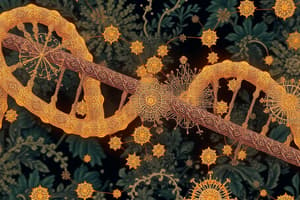Podcast
Questions and Answers
Which type of cell contains a nucleus?
Which type of cell contains a nucleus?
- Neither Prokaryotic nor Eukaryotic
- Eukaryotic (correct)
- Prokaryotic
- Both Prokaryotic and Eukaryotic
What is the basic unit of life?
What is the basic unit of life?
the cell
Mutations are one way genetic variation can occur.
Mutations are one way genetic variation can occur.
True (A)
In a food chain, plants are referred to as ________.
In a food chain, plants are referred to as ________.
Match the following body systems with their primary functions:
Match the following body systems with their primary functions:
Which law states that alleles separate during gamete formation?
Which law states that alleles separate during gamete formation?
What is the primary role of ribosomes in a cell?
What is the primary role of ribosomes in a cell?
Macroevolution involves changes within a species.
Macroevolution involves changes within a species.
Flashcards are hidden until you start studying
Study Notes
Cell Biology
- Basic Unit of Life: The cell is the fundamental unit of structure and function in living organisms.
- Types of Cells:
- Prokaryotic: Simple, no nucleus (e.g., bacteria).
- Eukaryotic: Complex, with a nucleus (e.g., animals, plants, fungi).
- Cell Structure:
- Organelles: Specialized structures (e.g., mitochondria for energy, ribosomes for protein synthesis).
- Cell Membrane: Semi-permeable barrier that regulates entry and exit of substances.
Genetics
- DNA Structure: Double helix made of nucleotides (adenine, thymine, cytosine, guanine).
- Genes: Segments of DNA that code for proteins and influence traits.
- Alleles: Different forms of a gene (dominant vs. recessive).
- Mendelian Genetics:
- Law of Segregation: Alleles separate during gamete formation.
- Law of Independent Assortment: Genes for different traits segregate independently.
- Genetic Variation: Caused by mutations, sexual reproduction, and gene flow.
Ecology
- Ecosystems: Communities of living organisms interacting with their environment.
- Biotic and Abiotic Factors:
- Biotic: Living components (e.g., plants, animals).
- Abiotic: Non-living components (e.g., climate, soil).
- Food Chains and Webs: Energy flow through trophic levels:
- Producers (plants) → Primary consumers (herbivores) → Secondary consumers (carnivores).
- Biodiversity: Variety of life forms; essential for ecosystem resilience.
Evolutionary Biology
- Natural Selection: Mechanism of evolution where organisms better adapted to their environment tend to survive and reproduce.
- Speciation: Process by which new species arise due to isolation or genetic divergence.
- Macroevolution vs. Microevolution:
- Macroevolution: Large-scale changes (e.g., emergence of new species).
- Microevolution: Small-scale changes within a species (e.g., allele frequency shifts).
- Fossil Record: Provides evidence of historical life forms and evolutionary transitions.
Anatomy and Physiology
- Human Body Systems:
- Skeletal: Framework, movement (bones).
- Muscular: Movement, posture (skeletal, smooth, cardiac muscles).
- Circulatory: Blood flow, nutrient transport (heart, blood vessels).
- Respiratory: Gas exchange (lungs, trachea).
- Digestive: Breakdown of food (stomach, intestines).
- Homeostasis: Maintenance of stable internal conditions (e.g., temperature, pH).
- Tissues: Groups of cells performing similar functions:
- Epithelial: Protection, secretion.
- Connective: Support, transport.
- Muscle: Movement.
- Nervous: Signal transmission.
The Cell
- The cell is the basic unit of life, responsible for all living processes.
- Prokaryotic cells are simple, lacking a nucleus, and are found in bacteria.
- Eukaryotic cells are more complex, containing a nucleus, and are found in animals, plants, and fungi.
- Organelles within cells are specialized structures that perform specific functions, for example:
- Mitochondria are responsible for producing energy.
- Ribosomes are responsible for protein synthesis.
- The cell membrane controls what enters and exits the cell.
Genetics
- DNA, the genetic material, is a double helix composed of nucleotides: adenine (A), thymine (T), cytosine (C), and guanine (G).
- Genes, segments of DNA, code for proteins and influence traits.
- Different forms of a gene are called alleles.
- Dominant alleles mask recessive alleles.
- Mendelian genetics explains the inheritance of traits:
- The Law of Segregation states that alleles separate during gamete formation.
- The Law of Independent Assortment states that genes for different traits segregate independently.
- Mutations, sexual reproduction, and gene flow contribute to genetic variation.
Ecology
- Ecosystems are composed of living organisms interacting with their environment.
- Biotic factors are living components, including plants and animals.
- Abiotic factors are non-living components, such as climate and soil.
- Energy flows through trophic levels in a food chain:
- Producers (plants) are consumed by primary consumers (herbivores), who are consumed by secondary consumers (carnivores).
- Biodiversity, the variety of life forms, is essential for ecosystem resilience.
Evolutionary Biology
- Natural selection is a mechanism of evolution where organisms better adapted to their environment survive and reproduce.
- Speciation, the formation of new species, occurs due to isolation or genetic divergence.
- Macroevolution involves large-scale changes, such as the emergence of new species.
- Microevolution involves small-scale changes within a species, such as shifts in allele frequencies.
- The fossil record provides evidence of historical life forms and evolutionary transitions.
Anatomy and Physiology
- The human body is comprised of various systems that work together:
- The skeletal system provides support and allows for movement.
- The muscular system enables movement and maintains posture.
- The circulatory system transports blood, nutrients, and oxygen throughout the body.
- The respiratory system facilitates gas exchange.
- The digestive system breaks down food for absorption of nutrients.
- Homeostasis is the maintenance of stable internal conditions, essential for survival.
- Tissues are groups of cells that perform similar functions:
- Epithelial tissue provides protection and secretion.
- Connective tissue supports and transports.
- Muscle tissue enables movement.
- Nervous tissue transmits signals.
Studying That Suits You
Use AI to generate personalized quizzes and flashcards to suit your learning preferences.




